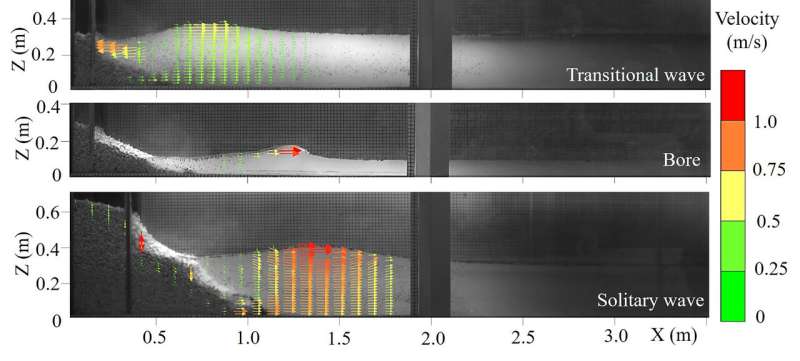Unstable rock pillars near reservoirs can produce dangerous water waves

In many coastal zones and gorges, unstable cliffs often fail when the foundation rock beneath them is crushed. Large water waves can be created, threatening human safety.
In this week's Physics of Fluids scientists in China reveal the mechanism by which these cliffs collapse, and how large, tsunami-like waves, known as impulse waves, are created. Few experimental studies of this phenomenon have been carried out, so this work represents valuable new data that can be used to protect from impending disaster.
The experiments were carried out in a transparent, rectangular box. A large body of water was placed at one end of the box and a granular pile at the other. The pile is separated from the water by a movable gate. When the gate is brought upward quickly, the pile collapses and slides into the water, inducing wave action.
The shape of the granular particles was chosen to resemble the shapes of samples from the Three Gorges Reservoir area in China. Motion of the body of water was observed with additional floating and suspended particles. Movements of this second group of particles was detected by a camera outside the box at 100 frames per second.
The investigators varied the width and height of the granular pile and, separately, the height of the body of water. The pile height-to-width ratio was found to be critical, determining how the pile collapses as well as the types of impulse waves produced.
The pile collapsed in four stages, eventually pushing water away. The resulting water movements were transferred back to the pile under certain conditions, creating vortices. Three types of water waves were generated: transition waves, solitary waves and bores.
Transition waves decay gradually as they propagate. Solitary waves, though, consist of a single water crest that moves rapidly, without decreasing its amplitude. In a bore, the top of the wave breaks and spills forward.
By fitting the observed experimental data to a formula, the investigators developed a way to predict which type of wave would be produced.
"These formulas are highly suitable for the collapse of partially submerged granular piles," said co-author Huang Bolin.
More information: "Experimental study on impulse waves generated by gravitational collapse of rectangular granular piles," Physics of Fluids (2020). DOI: 10.1063/1.5138709
Journal information: Physics of Fluids
Provided by American Institute of Physics



















